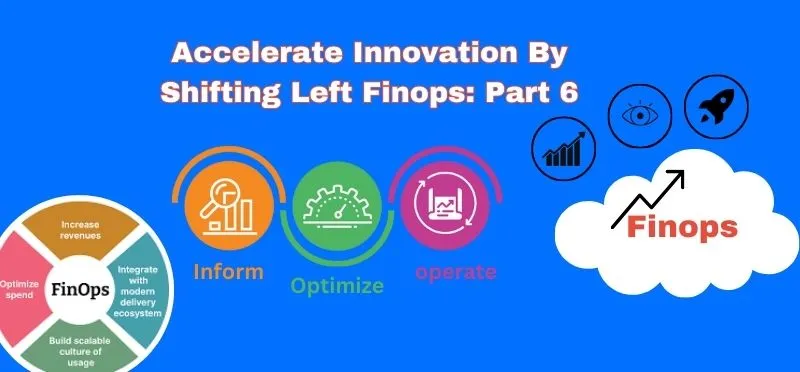Accelerate Innovation By Shifting Left Finops: Part 6
In today’s dynamic business landscape, where innovation is the cornerstone of success, organizations are constantly seeking ways to accelerate their innovation processes. One such methodology gaining prominence is Accelerate Innovation By Shifting Left FinOps Part 6. But what exactly does this term entail, and how can it revolutionize your innovation endeavors? In this comprehensive guide, we delve into the intricacies of Shifting Left FinOps and explore its profound implications for accelerating innovation.
Understand the Concept of Accelerate Innovation By Shifting Left FinOps Part 6
Shifting Left Finops is a strategic approach aimed at integrating financial operations (Finops) early in the software development lifecycle (SDLC). Traditionally, financial considerations were often addressed towards the end of the development process, leading to cost overruns, budget constraints, and inefficient resource allocation. However, by shifting these financial considerations “leftward” to the initial stages of development, organizations can proactively manage costs, optimize resources, and foster a culture of fiscal responsibility throughout the entire SDLC.
Read Also: Are You Facing An Error When You Run The Startdagservermaintenance.Ps1 Script?
The Advantages of Accelerate Innovation By Shifting Left FinOps Part 6
1. Cost Optimization
By embedding financial considerations early in the SDLC, organizations can identify cost-saving opportunities, mitigate financial risks, and optimize resource utilization. This proactive approach enables teams to make informed decisions that align with budgetary constraints, ultimately leading to cost optimization and enhanced financial efficiency.
2. Improved Resource Allocation
Shifting Left FinOps empowers organizations to allocate resources more effectively by providing visibility into the financial implications of various development initiatives. By understanding the cost implications upfront, teams can prioritize projects based on their strategic value and allocate resources accordingly, maximizing ROI and minimizing waste.
3. Enhanced Collaboration
One of the key benefits of Shifting Left FinOps is its ability to foster collaboration between finance, IT, and development teams. By involving financial stakeholders early in the development process, organizations can ensure alignment between financial objectives and technical initiatives, promoting synergy and driving innovation.
Read Also: Unleash Peak Performance In Java Applications: Overview Of Profile-Guided Optimization (PGO)
Implementing Innovation with Shifting Left FinOps Part 6
1. Cross-Functional Collaboration
Encourage open communication and collaboration between finance, IT, and development teams to ensure alignment of financial objectives with technical initiatives. Establishing cross-functional teams can break down silos and foster a culture of collaboration, driving innovation and accelerating time-to-market.
2. Integrated Tools and Technologies
Invest in integrated tools and technologies that facilitate the early integration of financial considerations into the SDLC. Leveraging automation tools, budgeting software, and cloud-based platforms can streamline financial processes, enhance visibility into costs, and optimize resource allocation, thereby accelerating innovation and driving competitive advantage.
3. Continuous Monitoring and Optimization
Establish robust monitoring mechanisms to track financial metrics throughout the development lifecycle. Implementing key performance indicators (KPIs), dashboards, and analytics tools can provide real-time insights into costs, resource utilization, and project performance, enabling teams to identify bottlenecks, iterate quickly, and optimize processes for maximum efficiency and innovation.
Read Also: Mueller She Wrote Twitter
Case Study: Transforming Innovation with Shifting Left FinOps Part 6
Let’s examine a real-world example of how Shifting Left Finops has transformed innovation within an organization. Company X, a leading technology firm, implemented Shifting Left Finops across its development projects, resulting in a significant reduction in development costs, improved resource allocation, and accelerated time-to-market for new products.
By embedding financial considerations early in the SDLC, Company X was able to identify cost-saving opportunities, optimize resource allocation, and foster a culture of fiscal responsibility across its development teams. As a result, the company experienced a 20% reduction in development costs, a 30% increase in ROI, and a 50% decrease in time-to-market for new products.
Read Also: Google, Chromebook, Tijd Om Te Switchen, Switch Naar Chromebook, Groei Je Bedrijf Met Google
Additional Resources: Further Exploration of Shifting Left FinOps Part 6
For those interested in delving deeper into the concept of Shifting Left Finops and its implementation strategies, we recommend exploring the following resources:
- Whitepapers: Dive into in-depth whitepapers authored by industry experts, providing comprehensive insights into the principles and practices of Shifting Left Finops.
- Webinars: Attend live webinars hosted by thought leaders and practitioners, offering practical tips, case studies, and interactive discussions on Shifting Left Finops implementation.
- Online Courses: Enroll in online courses offered by reputable institutions and training providers, covering topics such as financial management in software development, cost optimization strategies, and Shifting Left Finops best practices.
Conclusion
In conclusion, Accelerate Innovation By Shifting Left FinOps represents a paradigm shift in the way organizations approach financial operations within the context of software development. By integrating financial considerations early in the SDLC, organizations can optimize costs, enhance resource allocation, and drive innovation at an accelerated pace. As businesses continue to navigate the complexities of the digital landscape, embracing Shifting Left Finops is essential for staying competitive and fostering a culture of innovation.
